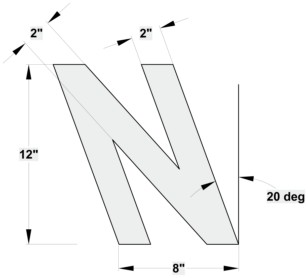Your N Number and Compliance with FAR 45 Subpart CWe have a web tool that allows our customers to create custom designs that comply with the Federal Regulations. On this page we discuss the regulations and show how we meet them when other vendors do not. If you want to skip the discussion and go directly to creating a custom design, here is a link to the tool. There are many FAA regulations of which a pilot must be aware. It is difficult to know them all. At Higher Graphics we believe it is our responsibility to learn as much as we can about the regulations that relate to our products. If you buy from us you have the right to expect that we have done our homework and that you do not need to learn the nuances of every regulation. When you buy registration numbers from any vendor they should meet FAR 45 Subpart C and the other applicable regulations. One would think that anyone making registration numbers would learn the regulations, but there are numerous cases on the web of vendors proudly displaying grossly non-compliant numbers as examples of their work. They have obviously not done their homework. We feel confident that we have done ours. Then there are the vendors who believe they meet the regulations, but who don't actually understand them. Thus is particularly true when slanting numbers. The regulations do not explicitly address slanting, but we believe that when slanting numbers the basic regulations still apply. Most vendors do not meet even the basic regulations when slanting. Here is a link that shows our position on slanting in more detail. In those areas that might be open to interpretation we have looked at how manufacturers have interpreted the regulations. We have also discussed the rules with various people in the industry, including FAA inspectors. In any case, we try to take the most conservative interpretation. For our international customers, we admittedly do not know the regulations for all countries. We have studied Annex 7 of the Chicago Convention of the International Civil Aviation Organization (ICAO). This is the basis for the requirements for most countries. Height RequirementsThe FAA height requirements for various types of aircraft show up in several different regulations. Since the requirements vary from aircraft to aircraft, call us and we can help you determine the requirements for your particular aircraft. Here is a short synopsis of these regulations: FAR 45.22 states that antique aircraft and aircraft used in exhibitions must have numbers at least 2" high. An antique aircraft is defined as "A small U.S.-registered aircraft built at least 30 years ago". FAR 45.29 b states that the default height for rotorcraft and fixed wing aircraft is 12" minimum. There are some exceptions to this rule. Experimental aircraft, gliders and most other aircraft (balloons, airships, powered parachutes, etc.) must have marks at least 3" high. FAR 45.29 (c), (d) & (e) Width, Thickness and Spacing RequirementsAll of these requirements are given as ratios. Mainly, relative to height. Width - FAR 45.29 (c) states that 'Characters must be two-thirds as wide as they are high, except the number “1”, which must be one-sixth as wide as it is high, and the letters “M” and “W” which may be as wide as they are high.' There are those that believe the width requirements are for minimum widths, except for "M" and "W" which have used the "may be" terminology. This interpretation is consistent with the fact that for most manufacturers the letter "1" is wider than one-sixth of the height. In most cases, we take the conservative approach and try to meet this value as precisely as possible. This is an area where many vendors do not meet the regulations. For example, Arial or any other variable width font does not comply with this requirement. The fonts for N numbers must be designed to meet the regulations. Most "off the shelf" fonts are not designed to meet the regulations and yet many vendors use these non-compliant fonts. Thickness - FAR 45.29 (d) states "Characters must be formed by solid lines one-sixth as thick as the character is high." This regulation is often not met when the number is slanted. Here is a link to further discussion on this subject. This discussion shows that most vendors produce non-compliant slanted numbers. Spacing - FAR 45.29 (e) states "The space between each character may not be less than one-fourth of the character width." There are two important things to notice about this requirement. First, it explicitly declares that it is a minimum. There is no need for interpretation. Second, it is given as a ratio to width. Ironically, giving the ratio relative to width opens the requirement up to interpretation. Does this mean that the spacing for a "1" is to be 1/24th of the height (1/4 * 1/6). What if the "1" is next to a "W"? Must the spacing then need to be 1/4 of the height? Is one supposed to split the space around each character, so that the space between the "1" and the "W" is at least 1/2 * (1/24 + 1/4) = 7/48 of the height. We have taken the approach that the spacing is 1/4 * 2/3 = 1/6 of the height in all cases. However, we have the code in place and can change the spacing algorithm to meet most interpretations. If you interpret this regulation differently, we can accommodate you. One thing is for sure, in most cases the spacing should be at least 1/6 of the height. Unfortunately, we often see numbers produced by other vendors that do not meet this basic requirement. Here are examples of 12" high characters that comply with the regulations.
|


